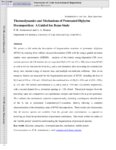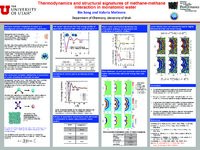|
|
Creator | Title | Description | Subject | Date |
| 301 |
 |
Miller, Joel Steven | Synthesis of layered (2-D) V-based bimetallic oxalates from non-aqueous media that cannot be synthesized from aqueous media | The reaction of (NBu4)3[VIII(ox)3] (1, ox = oxalate) and M(II) (M= Fe, Co, Ni, Cu) ions in MeCN, leads to the isolation of V-based coordination polymers of [N(n-Bu)4][FeIIVIII(ox)3]? 0.30{[N(n-Bu)4](BF4)} (2), [N(n-Bu)4][CoIIVIII(ox)3]?0.75{[N(n-Bu)4](BF4)} (3), [N(n-Bu)4][NiIIVIII(ox)3]?0.20{[N(n... | Magnetic; Coupling; Diffraction | 2006 |
| 302 |
 |
Miller, Joel Steven | Synthesis, structural, and magnetic characterization of substituted benzoimidazole-l-yl N,N'-dioxides | The crystal structures, EPR spectra and magnetic properties of the novel halogen- and cyano-substituted nitronyl nitroxide radicals 2-(2,6-dichlorophenyl)benzimidazolyl N,N'-dioxide, 6, 2-(2,6-difluorophenyl)benzimidazolyl N,N'- dioxide, 7, 2-(2-chloro-6-fluorophenyl)benzimidazolyl N,N'-dioxide, 8,... | Organic; Ferromagnetic; Coupling | 2004 |
| 303 |
 |
Voth, Gregory Alan | Systematic coarse-graining of nanoparticle interactions in molecular dynamics simulation | A recently developed multiscale coarse-graining procedure [Izvekov, S.; Voth, G. A. J. Phys. Chem. B 2005, 109, 2469] is extended to derive coarse-grained models for nanoparticles. The methodology is applied to C60 and to carbonaceous nanoparticles produced in combustion environments. The coarse-gra... | Systematic coarse-graining; Multiscale coarse-graining | 2005 |
| 304 |
 |
Poulter, Charles Dale | Tetartohedral twinning in IDI-2 from Thermus thermophilus: crystallization under anaerobic conditions | Type-2 isopentenyl diphosphate isomerase (IDI-2) is a key flavoprotein involved in the biosynthesis of isoprenoids. Since fully reduced flavin mononucleotide (FMNH2) is needed for activity, it was decided to crystallize the enzyme under anaerobic conditions in order to understand how this reduced co... | | 2014-01-01 |
| 305 |
 |
Miller, Joel Steven; Epstein, Arthur J. | Tetracyanoethylene-based organic magnets | Several classes of organic magnets based upon the tetracyanoethenide radical anion, [TCNE](.-), either unbound, (u), and (u4) bonded to zero, two and four metal sites have been reported. The putative (u4) bonded V(TCNE)x room temperature magnet has been extended to include M(TCNE)x(M = Mn, Fe, Co,... | Magnetization; Magnetic ordering; Oxidation | 1998 |
| 306 |
 |
Armentrout, Peter B. | Theoretical investigation and reinterpretation of the decomposition of lithiated proline and N-Methyl Proline | Lithium cation complexes of proline (Pro) and N-methyl proline (NMP) have been collisionally activated with xenon in a guided ion beam tandem mass spectrometer (GIBMS). In addition to the loss of the intact ligand, Pro and NMP, we observed two prominent fragmentation pathways involving the loss of (... | | 2014-01-01 |
| 307 |
 |
Wight, Charles Albert | Thermal activation of the high explosive NTO: sublimation, decomposition, and autocatalysis | Thermogravimetric analysis (TGA) and differential scanning calorimetry (DSC) show that the heating of 5-nitro-2,4-dihydro-3H-1,2,4-triazol-3-one (NTO) leads to competitive sublimation and condensed-phase exothermic decomposition. Model-free isoconversional analysis has determined activation energies... | NTO; Thermal activation; Differential scanning calorimetry; Exothermic decomposition; Competitive sublimation | 2002 |
| 308 |
 |
Wight, Charles Albert | Thermal analysis of high explosives: liquid state decomposition of RDX | Nonisothermal thermogravimetric analysis (TGA) and differential scanning calorimetry (DSC) have been applied to the thermal decomposition of RDX. Model-free isoconversional analysis of TGA and DSC traces show that RDX primarily evaporates in an open pan with an activation energy of Eα -100 kJ ... | RDX; Plastic explosives; Decomposition; Thermogravimetric analysis; Differential scanning calorimetry | 2000 |
| 309 |
 |
Wight, Charles Albert | Thermal decomposition of a melt-castable high explosive: isoconversional analysis of TNAZ | The thermal decomposition kinetics of the high explosive 1,3,3-trinitroazetidine (TNAZ) have been measured by nonisothermal differential scanning calorimetry (DSC). Samples of TNAZ in open pans and pierced pans undergo mainly melting (?Hfus = 27 ± 3 kJ mol-1) and vaporization (?Hvap = 74 ± 10 kJ m... | Thermal decomposition; Melt-castable high explosive; TNAZ; Nonisothermal differential scanning calorimetry; Exothermic decomposition | 2002 |
| 310 |
 |
Wight, Charles Albert | Thermal dissociation kinetics of solid and liquid ammonium nitrate | Thermogravimetry has been used to study the kinetics of the thermal dissociation of solid and liquid ammonium nitrate. Model-fitting and model-free kinetic methods have been applied to the sets of isothermal and nonisothermal measurements to derive kinetic characteristics of the processes. The appli... | Thermal dissociation kinetics | 2001 |
| 311 |
 |
Truong, Thanh | Thermal rate constants of the NO2 fission reaction of gas phase ?-HMX: a direct ab initio dynamics study | The NO2 fission reaction of gas phase ?-HMX has been studied using a direct ab initio method within the framework of microcanonical variational transition state theory (?VT). The potential energy calculations were calculated using the hybrid nonlocal B3LYP density functional theory with the cc-pVDZ ... | HMX; Fission reaction; Thermal rate constants; Microcanonical variational transition state theory | 2000 |
| 312 |
 |
Armentrout, Peter B. | Thermochemistry of small cationic iron-sulfur clusters | The kinetic energy dependences of the reactions of Fen 1 with COS (n=2-6) and CS2 (n=2-5) are studied in a guided-ion beam tandem mass-spectrometer. The main products arise from sulfur transfer and subsequent losses of Fe atoms. In the case of CS2 , this reactant also formally replaces one Fe atom ... | Iron-sulfur clusters; Endothermic reactions; Bond energy | 2002 |
| 313 |
 |
Armentrout, Peter B. | Thermochemistry of the activation of N2 on iron cluster cations: guided ion beam studies of the reactions of Fen+ (n=1-19) with N2 | The kinetic energy dependences of the reactions of Fen + (n=1-19) with N2 are studied in a guided ion beam tandem mass spectrometer over the energy range of 0-15 eV. In addition to collision-induced dissociation forming Fem + ions, which dominate the product spectra, a variety of FemN2+ and FemN+ p... | Metal clusters; Iron ions; Dinitrogen; Endothermic reactions; Collision-induced dissociation; Bond energies | 2006 |
| 314 |
 |
Armentrout, Peter B. | Thermodynamics and mechanism of protonated cysteine decomposition: a guided ion beam and computational study | A quantitative molecular description of the decomposition of protonated cysteine, H+Cys, is provided by studying the kinetic energy dependence of threshold collision-induced dissociation (CID) with Xe using a guided ion beam tandem mass spectrometer (GIBMS). Primary dissociation channels are deamida... | | 2014-01-01 |
| 315 |
 |
Armentrout, Peter B. | Thermodynamics and mechanisms of protonated diglycine decomposition: a guided ion beam study | We present a full molecular description of fragmentation reactions of protonated diglycine (H+GG) by studying their collision-induced dissociation (CID) with Xe using a guided ion beam tandem mass spectrometer (GIBMS). Analysis of the kinetic energy-dependent CID cross sections provides the 0 K barr... | | 2012-01-01 |
| 316 |
 |
Armentrout, Peter B. | Thermodynamics and mechanisms of protonated diglycine decomposition: a computational study | We present a full computational description of the fragmentation reactions of protonated diglycine (H+GG). Relaxed potential energy surface scans performed at B3LYP/6-31G(d) or B3LYP/6-311+G(d,p) levels are used to map the reaction coordinate surfaces and identify the transition states (TSs) and int... | | 2012-01-01 |
| 317 |
 |
Song, Bin; Molinero, Valeria | Thermodynamics and structural signatures of methane-methane in monatomic water | | | 2013 |
| 318 |
 |
Armentrout, Peter B. | Thermodynamics of ammonia activation by iron cluster cations: guided ion beam studies of the reactions of Fen+ (n=2-10,14) with ND3 | The kinetic energy dependences of the reactions of Fen 1 (n52 - 10,14) with ND3 are studied in a guided ion beam tandem mass spectrometer over the energy range of 0-10 eV. Dehydrogenation of ammonia to form FenND1 is found to be efficient and exothermic for n54 in agreement with previous FT-ICR stu... | | 2003 |
| 319 |
 |
Miller, Joel Steven ; Epstein, Arthur J. | Thermoelectric-power studies of (N-Methylphenazinium)x(Phenazine)1-x(Tetracyanoquinodimethanide), (0.5 <_ x <_ 1.0) | Temperature-dependent thermoelectric-power (S) studies of (N-methylphenaziniurn)(x)- (phenazine) (1-x) (tetracyanoquinodimethanide) [(NMP)x(phen) (1-x)(TCNQ) 1 show that for x = 0.5, S(T) is indentical to that of (quinolinium) (TCNQ)2. S(T) for 0.5 <x < 1.0 is intermediate between that of (NMP)(TC... | Semiconducting; Doping | 1979 |
| 320 |
 |
Miller, Joel Steven | Three-dimensional network-structured cyanide-based magnets | Introduction Magnets based on metal oxides have been important for hundreds of years. Magnetite, Fe3O4, Co-doped (y)-Fe2O3, and CrO2 are important examples. The oxide (O2-) bridge between the magnetic metal ions has filled p orbitals (Figure 1a) that provide the pathway for strong spin coup... | Magnetic; Ferrimagnetic; Magnetization | 2000 |
| 321 |
 |
Miller, Joel Steven; Epstein, Arthur J. | Three-dimensional ordering, spin excitations, and dilution effects in the quasi-1-D ferromagnetic (DMeFc)(TCNE) | The linear chain S = (1/2) molecular ferromagnet decamethylferrocenium tetracyanoethanide [(DMeFc) (TCNE)] has been studied by frequency-dependent ac susceptibility experiments. (X')(T) and (X") (T) exhibit maxima in the temperature range of 4.8 - 4.9 K, which corresponds to the transition tempe... | Temperature; Transition; Magnetic | 1991 |
| 322 |
 |
Armentrout, Peter B. | Threshold behavior of endothermic reactions: C+(2P) + H2 → CH+ + H | The reaction C+(2p) + H2 → CH+ + H (1) and its deuterium analog is a model system in ion-molecule chemistry. It is of interest due to its astrophysical significance, because it is an endothermic process, and because the interaction involves several potential energy surfaces. Experimental work ha... | Endothermic reactions; Translational energy; Threshold behavior | 1984 |
| 323 |
 |
Armentrout, Peter B. | Threshold collision-induced dissociation of hydrated cadmium (II): experimental and theoretical investigation of the binding energies for Cd2+(H2O)n complexes (n = 4-11) | The first experimentally determined hydration energies of Cd2+(H2O)n complexes, n = 4 - 11, are measured using threshold collision-induced dissociation in a guided-ion-beam tandem mass spectrometer coupled with an electrospray-ionization source. Kinetic-energy-dependent cross-sections are obtained a... | Hydrated cadmium; Collision-induced dissociation; Hydration energies; Cadmium complexes | 2010-02 |
| 324 |
 |
Armentrout, Peter B. | Threshold collision-induced dissociation of Sr2+ (H2 O) x complexes (x=1-6): an experimental and theoretical investigation of the complete inner shell hydration energies of Sr2+ | The sequential bond energies of Sr2+(H2O)x complexes, where x=1-6, are determined by threshold collision-induced dissociation using a guided ion beam tandem mass spectrometer equipped with an electrospray ionization source. The electrospray source produces an initial distribution of Sr2+(H2O)x compl... | | 2010 |
| 325 |
 |
Armentrout, Peter B. | Transition metal cluster ion chemistry | The reactivity and thermochemistry of ionic metal atoms and clusters has been explored using guided ion beam mass spectrometry. With this apparatus, cross sections of ion-molecule reactions can be measured from thermal energies to hundreds of eV. Application to metal cluster chemistry demonstrates... | Metal clusters; Manganese ions; Endothermic reactions | 1986 |

























